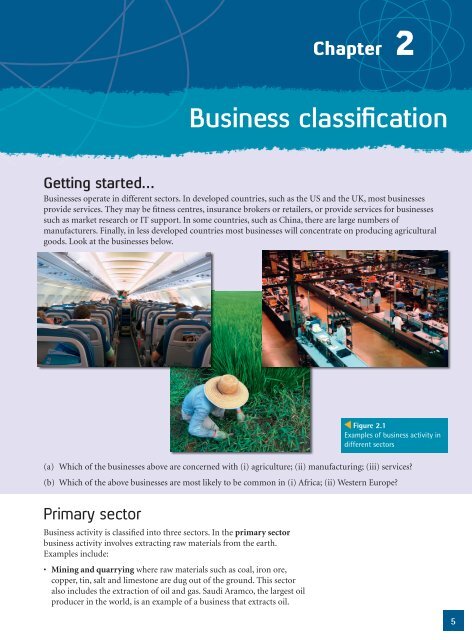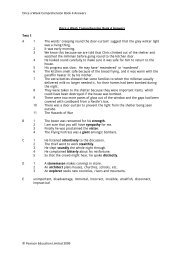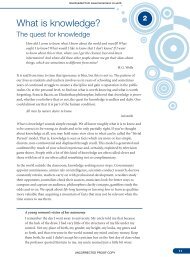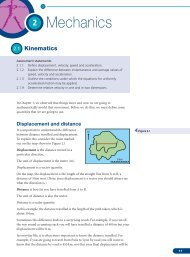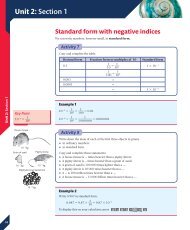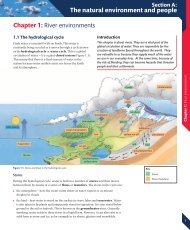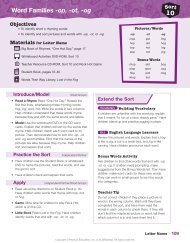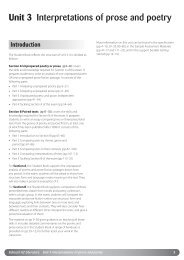Chapter 2 -- Business Classification - Pearson Schools
Chapter 2 -- Business Classification - Pearson Schools
Chapter 2 -- Business Classification - Pearson Schools
You also want an ePaper? Increase the reach of your titles
YUMPU automatically turns print PDFs into web optimized ePapers that Google loves.
What is business activity?<br />
<strong>Chapter</strong> 2<br />
<strong>Business</strong> classification<br />
Getting started…<br />
<strong>Business</strong>es operate in different sectors. In developed countries, such as the US and the UK, most businesses<br />
provide services. They may be fitness centres, insurance brokers or retailers, or provide services for businesses<br />
such as market research or IT support. In some countries, such as China, there are large numbers of<br />
manufacturers. Finally, in less developed countries most businesses will concentrate on producing agricultural<br />
goods. Look at the businesses below.<br />
Figure 2.1<br />
Examples of business activity in<br />
different sectors<br />
(a) Which of the businesses above are concerned with (i) agriculture; (ii) manufacturing; (iii) services?<br />
(b) Which of the above businesses are most likely to be common in (i) Africa; (ii) Western Europe?<br />
Primary sector<br />
<strong>Business</strong> activity is classified into three sectors. In the primary sector<br />
business activity involves extracting raw materials from the earth.<br />
Examples include:<br />
• Mining and quarrying where raw materials such as coal, iron ore,<br />
copper, tin, salt and limestone are dug out of the ground. This sector<br />
also includes the extraction of oil and gas. Saudi Aramco, the largest oil<br />
producer in the world, is an example of a business that extracts oil.<br />
5
• Fishing, which involves netting, trapping, angling and trawling fish.<br />
It also includes catching or gathering other types of sea food such<br />
as mussels, prawns, lobsters, crabs, scallops and oysters. China is the<br />
world’s largest fish producer.<br />
• Forestry, which involves managing forests to provide timber for wood<br />
products. It also involves protecting the natural environment, providing<br />
access and facilities to the public and managing wildlife habitats.<br />
• Agriculture, which involves a range of farming activities. This is<br />
probably the most important primary sector activity for most countries.<br />
Most agriculture is concerned with food production, but other examples<br />
include ornamental or exotic products such as cut flowers, nursery<br />
plants and tropical fish.<br />
Secondary sector<br />
In the secondary sector business activity involves converting raw materials<br />
into finished or semi-finished goods. Examples include metal working,<br />
car production, textile production, chemical and engineering industries,<br />
aerospace manufacturing, energy utilities, engineering, food processing,<br />
construction and shipbuilding. In many countries this sector has declined<br />
in recent years.<br />
Key terms<br />
De-industrialisation – the<br />
decline in manufacturing.<br />
Primary sector – production<br />
involving the extraction of raw<br />
materials from the earth.<br />
Secondary sector – production<br />
involving the conversion of raw<br />
materials into finished and semifinished<br />
goods.<br />
Tertiary sector – the provision<br />
of services in the economy.<br />
Tertiary sector<br />
The tertiary sector involves the provision of services. There is a wide<br />
variety of services and some examples are given below:<br />
• Professional services such as accountancy, legal advice and medical care.<br />
• Transport such as train, taxi, bus and air services.<br />
• Household services such as plumbing, decorating, gardening and house<br />
maintenance.<br />
• Leisure services such as television, tourism, swimming pools and<br />
libraries.<br />
• Financial services such as banking, insurance, and pensions.<br />
• Commercial services such as freight delivery, debt collection, printing<br />
and employment agencies.<br />
Question 1<br />
Jill and Ronnie Sanchez have owned a farm for 40 years. They grow a range of root vegetables such as carrots,<br />
swedes, turnips and parsnips. They have a contract to supply two local supermarkets and also sell to other<br />
shops in the area. In the 1970s, Jill and Ronnie employed up to 12 workers; however, because of mechanisation<br />
they now just employ three.<br />
6
<strong>Business</strong> classification<br />
(a) Using examples from this case, explain the<br />
difference between the primary and the<br />
tertiary sectors.<br />
(b) Look at Figure 2.2. What has happened<br />
to the number of people employed in<br />
agriculture in the UK since 1960?<br />
(c) Explain one possible reason for the pattern<br />
described in (b).<br />
Employees in UK Agriculture<br />
(000s)<br />
1200<br />
1100<br />
1000<br />
900<br />
800<br />
700<br />
600<br />
500<br />
1118<br />
952<br />
654<br />
564<br />
400<br />
419 402<br />
300<br />
1960 1970 1980 1990 2000 2007<br />
Year<br />
Source: adapted from www.bls.gov/fls/lfcompendium.pdf<br />
Figure 2.2 Employment in agriculture, UK 1960-2007<br />
Changes in sectors<br />
The number of people employed in each sector<br />
does not stay the same. Different sectors grow and<br />
decline over time. In the UK, before the Industrial<br />
Revolution began in the late 18th century, most<br />
production was in the primary sector. During the<br />
19th century secondary production expanded rapidly<br />
as manufacturing grew as a result of the Industrial<br />
Revolution. However, in the last 60 years the tertiary<br />
sector has started to expand at the expense of<br />
manufacturing. The decline in manufacturing is<br />
called de-industrialisation. Figure 2.3 shows the<br />
pattern of employment in manufacturing and services<br />
in the UK between 1960 and 2007. Similar patterns<br />
can be identified in other developed nations. Why has<br />
manufacturing declined in developed countries while<br />
services have grown?<br />
• People may prefer to spend more of their income<br />
on services than manufactured goods. There<br />
has also been a decline in demand for the goods<br />
produced by some of the traditional industries in<br />
manufacturing, such as shipbuilding and textiles.<br />
• Recently there has been fierce competition in the<br />
production of manufactured goods from developing<br />
countries such as India, China and Brazil.<br />
• As countries develop the public sector grows. Since<br />
the public sector mainly provides services, this adds<br />
to the growth of the tertiary sector.<br />
• Advances in technology means employment in<br />
manufacturing falls because machines replace<br />
people.<br />
Employees in Manufacturing<br />
(000s)<br />
Employees in Services (000s)<br />
10 000<br />
9000<br />
8000<br />
7000<br />
6000<br />
5000<br />
4000<br />
3000<br />
24 000<br />
22 000<br />
20 000<br />
18 000<br />
16 000<br />
14 000<br />
12 000<br />
10 000<br />
8517 8465<br />
1960<br />
11 642<br />
7081<br />
5992<br />
1970 1980 1990<br />
Year<br />
13 066<br />
15 291<br />
17 811<br />
1960 1970 1980 1990<br />
Year<br />
4617<br />
3728<br />
2000 2007<br />
20 296<br />
22 476<br />
2000 2007<br />
Figure 2.3<br />
The numbers of people employed in manufacturing and<br />
services in the UK 1960–2007<br />
7
<strong>Chapter</strong> review – <strong>Business</strong> sectors<br />
Banco Santander<br />
In 2008, Banco Santander, the third largest bank in the world, made a<br />
profit of €8,876 billion. The Spanish-based bank also has operations in<br />
Europe and Latin America. It has grown rapidly recently since buying<br />
other banks such as the UK’s Abbey, Alliance & Leicester and Bradford &<br />
Bingley. In 2008, it doubled its number of retail outlets.<br />
VT Garments<br />
Source: adapted from www.santander.com<br />
Thailand is one of the world’s largest textile manufacturers and VT<br />
Garments is one of the largest producers in the country. It produces a<br />
range of clothes such as ski jackets and pants, shorts, jogging suits and<br />
T-shirts. Its customers include The North Face, Nike, Patagonia and<br />
Nautica. The business has grown rapidly in the last<br />
20 years. In 1981 it employed 120 people. By 2007 this had increased<br />
to 3,500.<br />
Spain<br />
3%<br />
29%<br />
68%<br />
Thailand<br />
10%<br />
44%<br />
46%<br />
Source: adapted from www.vtgarment.com<br />
Wagagai Ltd<br />
Wagagai Ltd is a flower farm in Uganda. The company began in 1998<br />
exporting roses to the Netherlands. Soon after the farm diversified into<br />
chrysanthemum cuttings. Today, about 260 million chrysanthemum<br />
cuttings are produced in more than 22 acres of greenhouses. In 2005<br />
the owners stopped producing roses and approached German company<br />
Selecta First Class about producing cuttings. This was a success and Selecta<br />
and Wagagai formed a joint venture to supply international markets.<br />
Source: adapted from www.greenhousegrower.com<br />
Uganda<br />
33%<br />
42%<br />
25%<br />
(a) Using examples from the case above explain what is meant by<br />
(i) secondary production; (ii) tertiary production.<br />
(b) Look at Figure 2.4. Which nation relies most on the<br />
secondary sector for its output? Explain your answer.<br />
(c) (i) What is meant by de-industrialisation?<br />
(ii) Which of the countries in Figure 2.4 have been subject<br />
most to de-industrialisation?<br />
(d) How do you think VT Garments has been affected by<br />
de-industrialisation in western countries?<br />
(4 marks)<br />
(2 marks)<br />
(2 marks)<br />
(2 marks)<br />
(2 marks)<br />
(e) What do you think are the main causes of de-industrialisation? (8 marks)<br />
Agriculture<br />
Industry<br />
Services<br />
Source: adapted from World Development<br />
Report, World Development Indicators,<br />
World Bank<br />
Figure 2.4<br />
Sector output in Uganda, Thailand<br />
and Spain (GDP %). GDP (Gross<br />
Domestic Product) is the total output<br />
in the economy<br />
8


